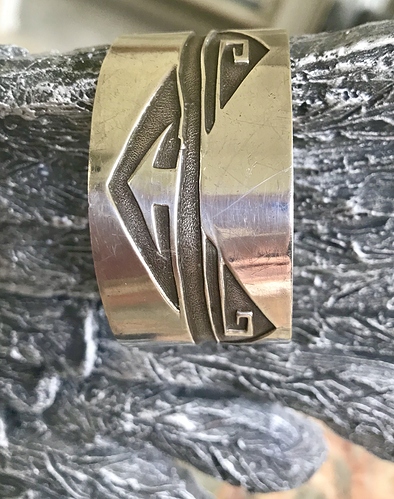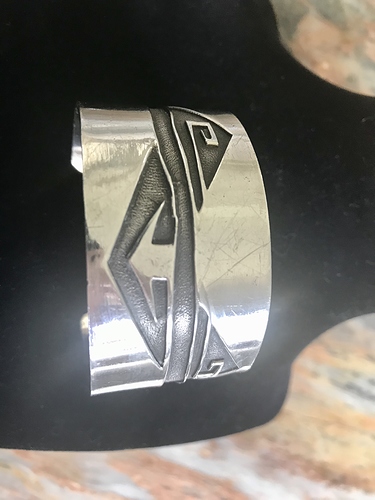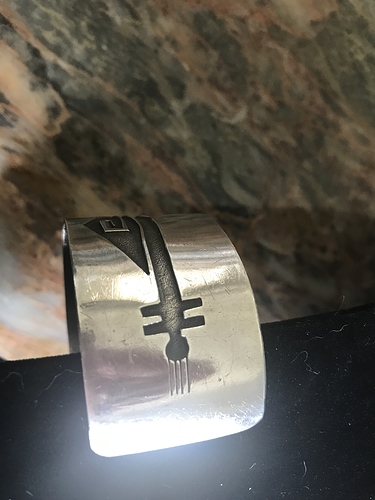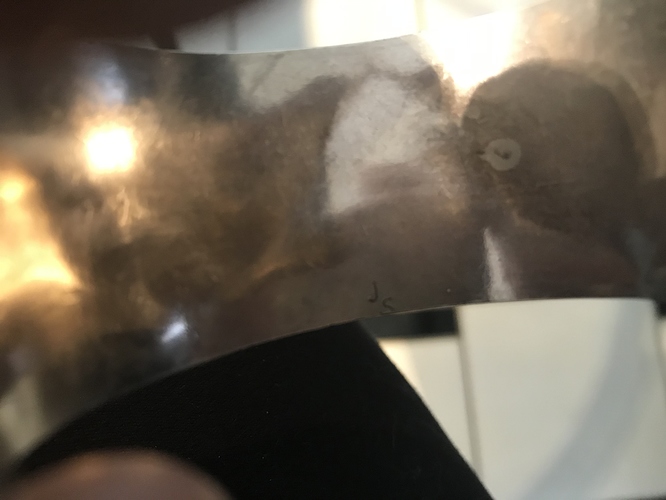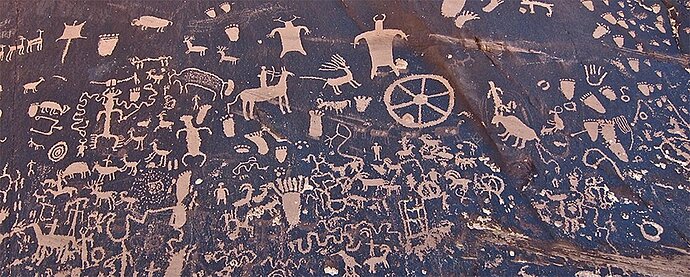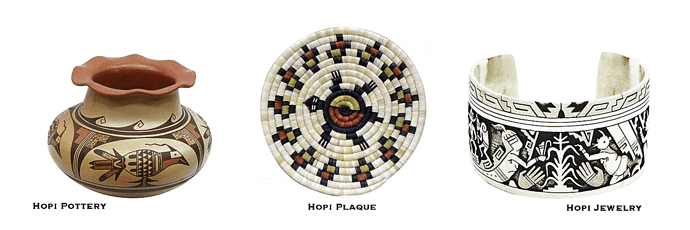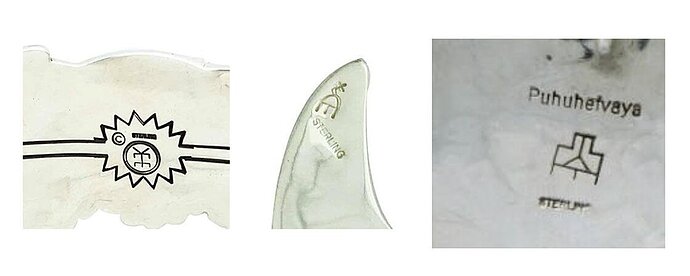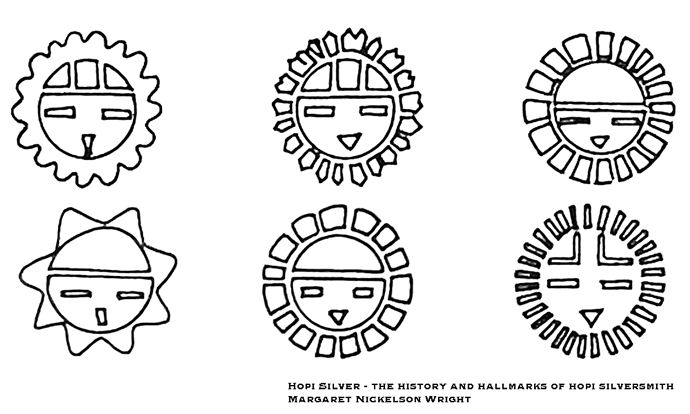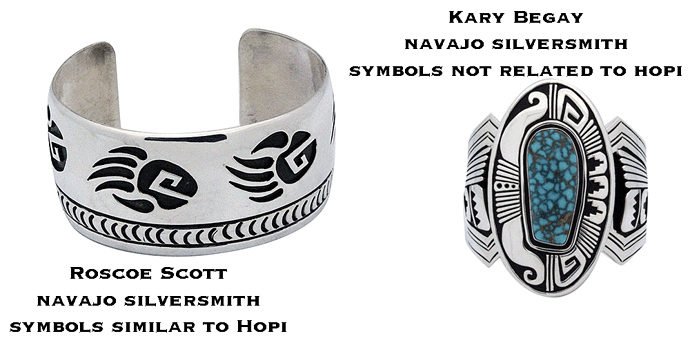Can anyone help me ID this cuff bracelet? I think it’s Hopi but not sure…
Hmmm, cast piece, not overlay. No motifs that I would associate with Hopi work.
Any idea on what it is? Weighs 56 grams
Here is a newsletter I just sent out that I thought you might like to read to learn more about Hopi jewelry.
Hopi Jewelry - What’s Different
Hopi is in a very remote part of Arizona. Also, it is surrounded on all sides by the Navajo Reservation. That means in the early days they didn’t receive the number of tourists that the Navajo and Zuni tribes did that were located much closer to a main highway and the train. When the Hopi first learned the art of silver making in the late 1800s it was taught to them by a Zuni silversmith and the style would have been what we think of Navajo jewelry looking like. Also, you didn’t have a large number of silversmiths because the demand wasn’t high for the work. It was a skill that was used more for trading and personal adornment then it was for making a living.
It would take the Hopi silversmiths over 40 years before they began to develop their own Hopi style of jewelry. The style would draw on the culture and incorporate symbols from pottery and rock walls that had been filled with petroglyphs documenting the beliefs and history of the Hopi for the last thousand years. They would accomplish this by developing a jewelry making technique called overlay. An artist would use two pieces of silver, the bottom piece would be a solid piece and the top would have the symbols cutout and laid over the bottom. The majority of these creations would be all silver works without stones.
Symbols
The Hopi people have a very rich history and have been in the Southwest for a very longtime. They built their villages on high mesas and one of those villages, Oraibi is the oldest continuously inhabited settlement in the United States. This has allowed the Hopi to hold onto many of their traditional beliefs and customs. You could also say they have an historical account of their way of life and beliefs written on the mesas surrounding their villages in the way of petroglyphs. Plus, a pottery and weaving tradition that dates back hundreds of years. As their pottery and weaving making techniques improved, they would decorate their pieces with symbols that represented their beliefs and traditions. These symbols are unique to the Hopi and those are what the silversmiths would draw on to decorate their silver.
Symbols that help identify Hopi silver:
- Water, Cloud & Sun Symbols. The Hopi are dry farmers and depend on the water and sun to grow their crops and these symbols are at the center of their culture
- The Hopi have a belief system that incorporates kachinas that represent spirits. Different than the Navajo, similar to the Zuni who recreate these kachinas in an inlaid stone style.
- The Hopi believe that they emerge into this world from a previous world, it is what the kiva represents, and they use a ladder to make that journey.
- This could have different meanings. However, the Hopi believe that when they emerged into this world that they were required to go on a pilgrimage to all four corners of the world before they returned to the high mesas in Arizona. It could represent that journey.
- The Hopi are made up of a clan system and those clans can be represented by animals like parrots and bears that make their way into their art.
It is a fascinating culture and I would suggest learning more about the Hopi. A great resource is the Book of the Hopi. Try getting a copy through the Mesa Verde Museum Association.
Hallmarks
The petroglyphs surrounding the Hopi mesas tell a history of the people who have been there for over a thousand years. You will find many of those symbols represent the clans of the Hopi. These symbols are sacred to the Hopi and in return are represented in their artwork. It is a society that has a deep connection with those symbols. So, it makes sense that silversmiths choose those symbols as their hallmarks. A majority of Hopi silversmiths use a symbol as a hallmark. You will find a number of symbols related to an individual’s clan and those dealing with farming like the sun, water and corn. This is very different than full names and initials like you see with a number of Navajo and Zuni silversmiths.
Styles of hallmarks that help identify Hopi silver work can include:
- Clan
- Plants
- Weather
- Kachinas
Of course, you will find some artists who use initials, but even the style of these initials has an artistic touch to them compared to a letter stamp.
In the Southwest Native American Arts are very important to the economy of many Native American tribes. After World War II the US Department of the Interior developed programs to promote this art. This program would help develop a number of Hopi silversmiths and eventually lead to the creation of the Hopi Silvercraft Cooperative Guild. A number of different guild hallmarks have been created and accompany the silversmith’s own hallmark on pieces that were made in this program. This is a helpful identifier when researching older pieces of Hopi jewelry.
Imitations or Inspiration
In another email we looked at ways to identify Zuni jewelry. One of the things we learned about Zuni jewelry is that this work is all about the stone. Zuni silversmiths have defined their work by small petit point, needlepoint, small turquoise cuts and inlaid stones. Hopi jewelry is all about the silver with the majority of works having no stones. That means when we are trying to determine if a piece is Hopi our other thought is maybe it is a piece of Navajo jewelry. Zuni silversmiths just don’t concentrate enough of their skill on the silver work. Hopi silversmiths developed a technique called overlay and you will find a number of Navajo silversmiths have incorporated this technique into their jewelry creations.
Hopi artists can demand very high prices for their work. Plus, the Hopi tribe is much smaller than the Navajo tribe, so you just have a significant lower number of Hopi silversmiths than you do Navajo. With a much larger population of Navajo silversmiths that creates a tougher market to demand higher prices for their work. That means you will find a few Navajo silversmiths who try to take advantage of this small supply/high demand Hopi market and recreate their version of overlay jewelry, it might even have a symbol for a hallmark. However, it is really important to understand that Native American art has evolved in a number of very well-respected Navajo artists use overlay techniques that provide a style and have nothing to do with Hopi symbolism or riding the bandwagon.
Many collectors and dealers refer to this style of Navajo overlay jewelry as Navahopi work. We will dedicate another email to this subject later.
